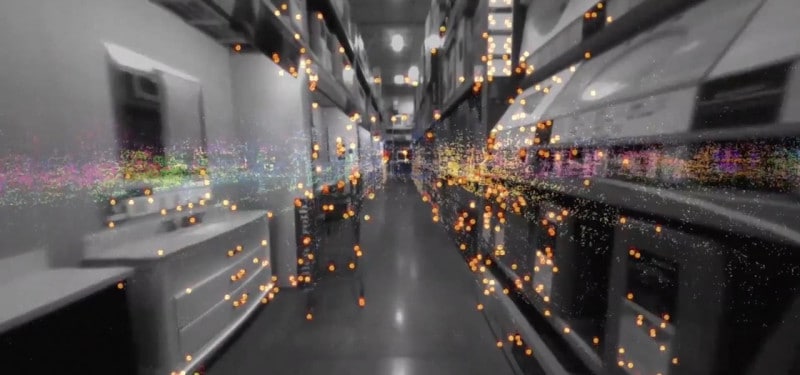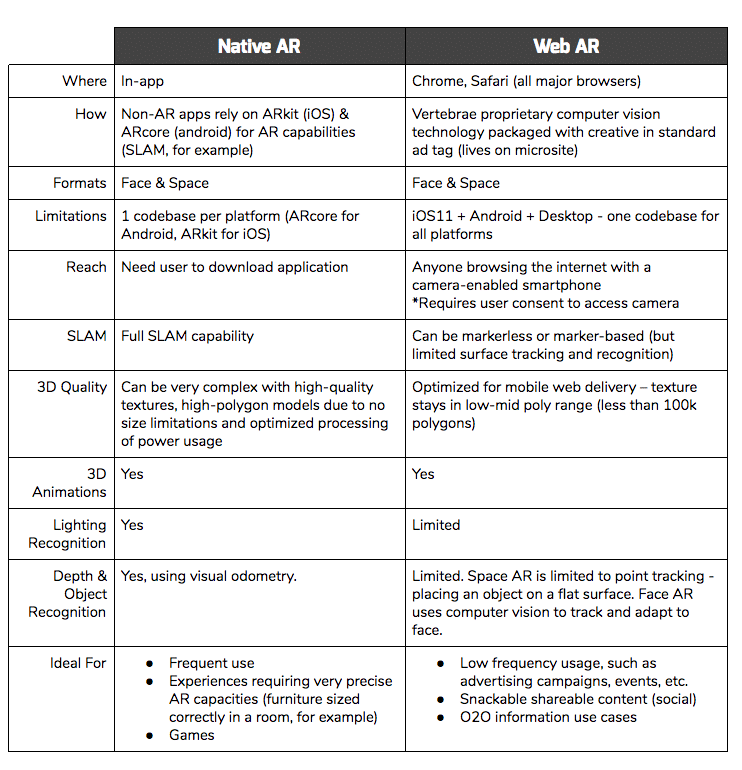When it comes to augmented reality advertising, there are currently two routes to consumers: in-app and web AR. Both have benefits and limitations, though they may not be immediately clear to marketers looking to maximize their advertising efforts. To better understand these distribution channels, let’s take a look under the hood of AR as a whole, from both a technological and user experience perspective. By the end of this post, we’ll know, unequivocally, the answer to one of 2018’s great mysteries…
Native vs Web AR – Which is Better?
From the top, augmented reality involves placing 2D and 3D content into a user’s environment in real time. Mobile AR, made possible via the high-fidelity camera built into later model smartphones, is the focus of this particular post. Down the road, we’ll all come to expect hands-free AR experiences as part of our daily lives, but for now, the reach of AR is through the lens of the smartphone.
Once an AR experience is initiated, the user’s environment is captured via the phone’s camera feed, allowing creative overlays that adapt to user movement and device positioning in real time. The key here is real time. Until recently, AR on smartphones was possible as an afterthought, adding 2D graphics to an already taken snapshot as an overlay. Technological advancements in things like computer vision and machine learning have brought true mobile AR to the masses.
But how? Computer vision. Machine learning. SLAM. All great buzzwords, but what do they mean for AR? For that, let’s take a look back at 2017 with the releases of ARKit from Apple and ARCore from Google. These updates enabled AR across the app ecosystem by packaging up computer vision and machine learning technologies, the end result often referred to as SLAM, into tidy dev-friendly kits.
SLAM, simultaneous localization and mapping, allows environment charting and tracking, necessary for the real-time rendering that is AR.

Computer vision is the ability for a machine to interpret visual surroundings. Finally, machine learning is the process of teaching a machine (smartphone) to interpret the world correctly on its own and learn from continued experience. For example, to interpret and track a pair of AR sunglasses to a face, we must first teach a computer (machine) to recognize a face. Computer vision provides the visual data (in this case, a face) for machine learning to interpret and SLAM allows for correct placement of a new object (AR) on the mapped and tracked environment. Voila. You are now an AR expert. But there’s more.
Distribution
ARKit and ARCore solved major problems for in-app AR. WebAR has yet to harness the full capabilities of SLAM, but that doesn’t mean AR on mobile web isn’t a slam dunk of an opportunity for marketers. (See what we did there?) While AR experiences served in the closed ecosystems of Snapchat and Facebook are scalable based purely on each platform’s extensive user base, the same cannot be said for in-app AR outside the walled gardens. Mobile web AR, on the other hand, is accessible to just about anyone browsing the web with a camera-enabled smartphone. Sounds exciting? We thought so too.
But if not via SLAM, then how? Web AR experiences are essentially AR-enabled web pages, using Javascript to package and deploy computer vision libraries and AR creative. Similar to SLAM, but lighter, and only recently possible thanks to updates including WebRTC, a protocol that allows browsers to request camera access from a user. In an app, camera access may already be enabled, in which case, an AR experience, which inherently requires camera access, is one step ahead. However, this requires that the app is already downloaded on the user’s phone and being used and camera-enabled. One step forward, two steps back.
On the other hand, mobile web AR works on both Android & iOS devices, across all major browsers. That said, users must be on later versions of browsers or WebRTC will not request camera access. In order to avoid limiting AR advertising experiences to only users with later device models, fallback behavior can be created, enabling users to “experience” AR via an already captured photo.
Limitations
Still, there are limitations. Web AR does not currently leverage the full capacity of in-app AR. Both ARKit and ARCore allow for incredibly powerful object, depth, surface, and lighting recognition, allowing comprehensive placement and tracking of objects in an environment. Web AR is capable of markerless object placement and tracking, but not as in-depth. The experience needs to be light in weight to be delivered seamlessly over the web, meaning creative must be optimized. Lighting recognition. Depth. Multifaceted experiences with detailed 3D creative. All possible but not all in one. At least not yet.
So users can place an object and walk around it, but they cannot necessarily walk into a placed world similar to the in-app portals, for example, we’re seeing created with ARkit and ARCore. Essentially, mobile web AR is the lite version of in-app AR, perfect for snackable, highly shareable AR experiences from the likes of innovative marketers. For a side-by-side comparison, see the table below. Note, in the case of mobile web AR, we’re talking about this from our perspective, as it’s what we know.
Apples to Apples

And the Winner is…
In conclusion, whether in-app or on the web, there is A LOT that goes into delivering compelling AR. And the technology powering these experiences is maturing daily. Just a year ago, in-app AR was only viable in AR apps. WebAR was experimental, at best. Today in-app AR is transformative and web AR is breaking down walls in terms of deep consumer engagement at scale. So which is right for you? It depends on your goals. We’d recommend both, of course, as a cross-platform strategy tends to lead to successful marketing outcomes. For more on how to get up and running in AR across platforms, check out our most recent 3-part series covering AR advertising on Snapchat, Facebook, and of course, mobile web.
Not a current customer but ready to get started?
Demo the Platform Today!Already a current customer? Log in to Axis Today!

